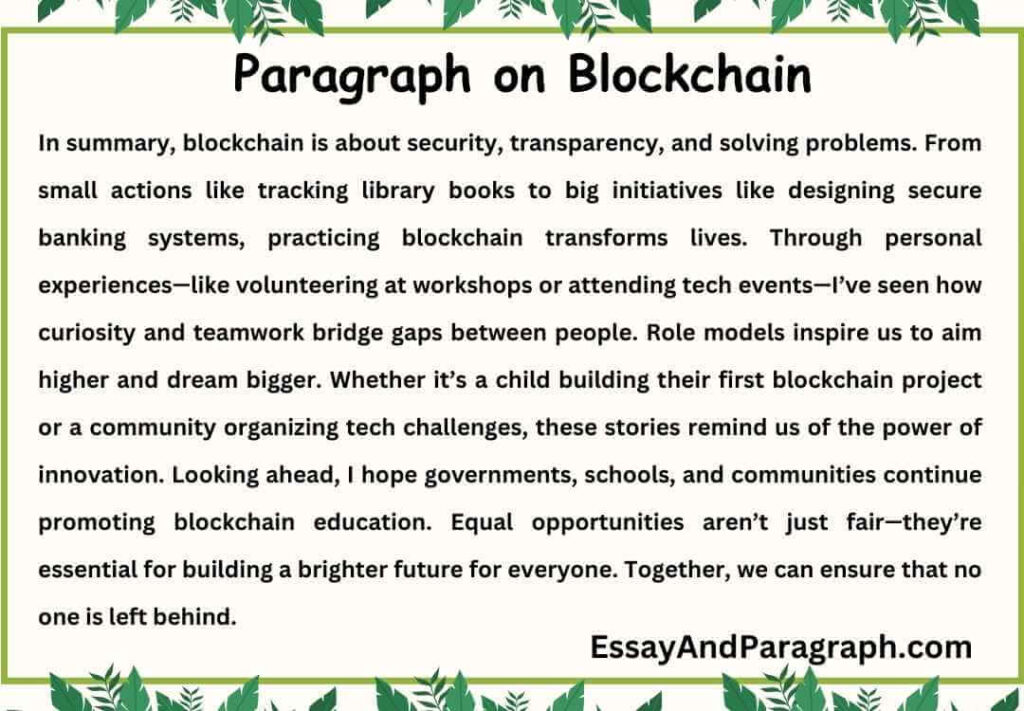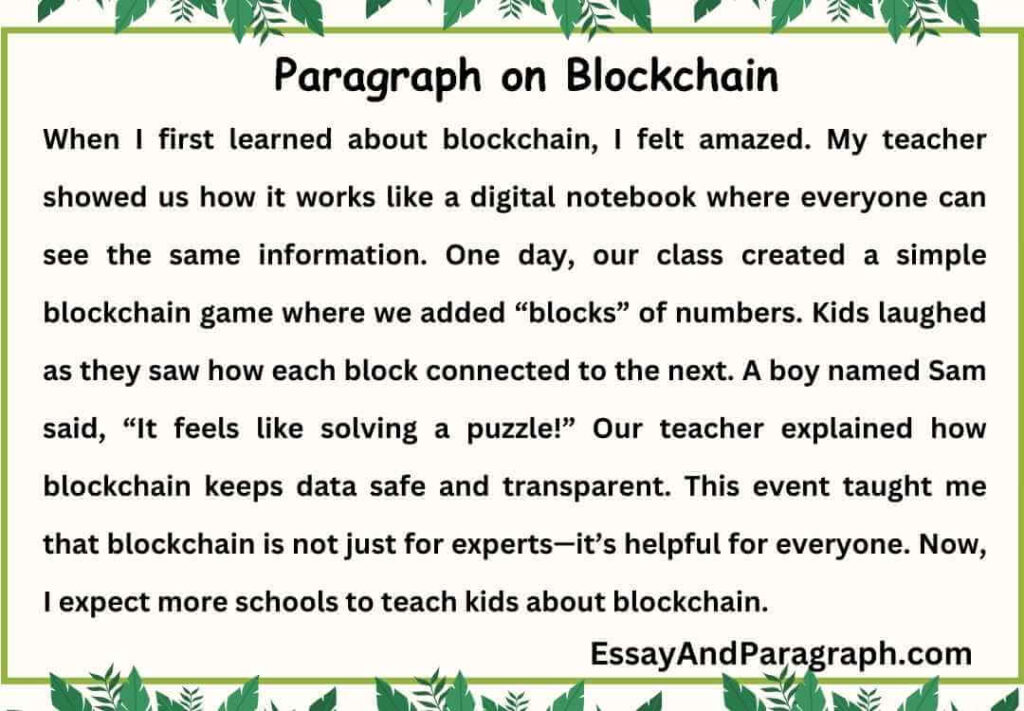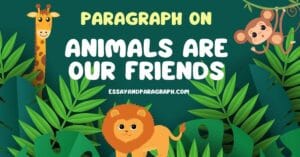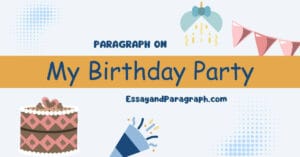Have you ever wondered how people can send money or share information securely without anyone tampering with it? Blockchain makes this possible! As someone who has studied and written about technology for years, I’m excited to share simple yet fascinating ideas with you. In this article, we will learn how to write paragraphs on blockchain in different lengths (100, 150, 200, 250, and 300 words). By the end, you’ll understand why blockchain matters and how it’s shaping the future. Let’s dive into this exciting topic together!
Paragraph on Blockchain [100 words]
When I first learned about blockchain, I felt amazed. My teacher showed us how it works like a digital notebook where everyone can see the same information. One day, our class created a simple blockchain game where we added “blocks” of numbers. Kids laughed as they saw how each block connected to the next. A boy named Sam said, “It feels like solving a puzzle!” Our teacher explained how blockchain keeps data safe and transparent. This event taught me that blockchain is not just for experts—it’s helpful for everyone. Now, I expect more schools to teach kids about blockchain.

Paragraph on Blockchain [150 words]
The idea of blockchain made me curious and excited. Last summer, my school held a workshop where students learned how blockchain stores information safely. At first, some kids were confused because they didn’t know how it worked. But soon, everyone was laughing as they built their own mini-blockchain using paper and markers. Volunteers like my friend Mia helped explain how blockchain helps banks track money or farmers sell crops fairly. These interactions showed me how useful blockchain can be. After the workshop, many students felt inspired to learn more about technology. Some even started dreaming of becoming blockchain developers. The outcome was inspiring—people realized they could create amazing things. Looking ahead, I hope more communities offer programs like this. Blockchain isn’t just about tech; it’s about trust and fairness.
Paragraph on Blockchain [200 words]
Learning about blockchain filled me with determination. Recently, my class visited a tech center where kids from different schools gathered to explore blockchain. We saw how it tracks donations for charities so people know exactly where their money goes. One girl, Lily, said, “I want to use blockchain to help others someday!” Our teacher explained how blockchain connects data securely and prevents cheating. Back at school, we organized a “blockchain challenge” where students created simple projects, like tracking steps in a fitness app. Seeing classmates cheer after completing their projects reminded me that teamwork brings success. Moving forward, I believe more schools will teach kids about blockchain. Blockchain ensures that no one feels left out. Every small step toward learning technology makes the world a better place.
Paragraph on Blockchain [250 words]
Thinking about blockchain always makes me optimistic. Imagine a world where blockchain helps doctors, farmers, and teachers every day. Last year, I attended a workshop where students practiced creating blockchain solutions to solve real-world problems. Groups were given tasks, like designing a system to track food safety or prevent fake products. At first, disagreements arose, but mentors encouraged us to listen and work as a team. One group decided to build a blockchain app to track school supplies donated to poor areas. These activities proved that creativity builds stronger solutions. After the workshop, our school started holding regular blockchain days where students could experiment. Teachers noticed fewer conflicts and more cooperation. Parents praised the initiative, saying their children seemed more confident. Looking ahead, I expect more schools to adopt programs like this. Blockchain ensures that no one feels ignored. When we stand together, amazing things happen. Every small step toward innovation makes the world a better place.
Paragraph on Blockchain [300 words]
Blockchain fills me with hope because it promises fairness and happiness for all. A few months ago, I volunteered at a center that taught kids how to design and use blockchain systems. Many families struggled to understand how blockchain works, so volunteers provided free lessons and tools. To assist them, tech experts held sessions explaining how blockchain keeps data safe and fair. I met Fatima, a girl who dreamed of becoming a coder but lacked confidence. With encouragement from mentors, she built her first blockchain project—a system to track library books. Her progress inspired others around her. During gatherings, kids shared their creations, laughed, and learned from each other. These interactions broke down walls and built trust. Over time, Fatima won a local blockchain competition. Watching her transformation moved me deeply. It reminded me that opportunity changes lives. After volunteering, I realized how much communities gain when they embrace blockchain. Looking to the future, I imagine a world where everyone participates in learning technology. Governments, organizations, and individuals must work together to remove barriers. Blockchain ensures that talent and hard work are rewarded, no matter who you are. Together, we can build a brighter tomorrow for all.
FAQs on Blockchain
What is blockchain?
Blockchain is a digital system that stores information in blocks connected like a chain. It’s used to track transactions, like money or data, securely and transparently. For example, blockchain helps cryptocurrencies like Bitcoin work.
Why is blockchain important?
Blockchain is vital because it prevents fraud and ensures fairness. For instance, it helps banks track money and farmers sell crops fairly. Investing in blockchain benefits everyone by advancing industries and improving trust.
How can students learn about blockchain?
Students can join workshops, attend tech events, or use online tools to create simple blockchain projects. Schools often provide apps and guides for hands-on learning. Organizing competitions also encourages creativity. Every effort counts toward mastering technology.
What challenges hinder blockchain?
Challenges include high costs, lack of awareness, and technical complexity. For example, not all schools have blockchain programs. Overcoming these requires funding, education, and collaboration. Progress takes time, but every step matters.
Can blockchain improve societies?
Absolutely! Blockchain improves societies by making systems fairer and more efficient. For example, it helps charities track donations and governments prevent corruption. Investing in blockchain creates lasting benefits for everyone.
Quotes Related to Blockchain
- “Blockchain is the tech. Bitcoin is merely the first mainstream manifestation of its potential.” – Marc Kenigsberg
- “Trust is the foundation of the new blockchain economy.” – Unknown
- “The blockchain does one thing: It replaces third-party trust with mathematical proof.” – Adam Draper
- “Blockchain is the biggest technological breakthrough since the internet.” – Unknown
- “Innovation distinguishes between a leader and a follower.” – Steve Jobs
- “We are stuck with technology when what we really want is just stuff that works.” – Douglas Adams
- “Blockchain will do to banks what email did to postal services.” – Bill Gates
Summary on Blockchain
In summary, blockchain is about security, transparency, and solving problems. From small actions like tracking library books to big initiatives like designing secure banking systems, practicing blockchain transforms lives. Through personal experiences—like volunteering at workshops or attending tech events—I’ve seen how curiosity and teamwork bridge gaps between people. Role models inspire us to aim higher and dream bigger. Whether it’s a child building their first blockchain project or a community organizing tech challenges, these stories remind us of the power of innovation. Looking ahead, I hope governments, schools, and communities continue promoting blockchain education. Equal opportunities aren’t just fair—they’re essential for building a brighter future for everyone. Together, we can ensure that no one is left behind.




